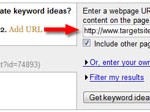There is nothing I love more than researching a market, unearthing lucrative keyword verticals and building out a site.

Crash Course in Organic SEO
Sure, there are a million and one ways to accomplish the same task, but despite the fundamental differences in approach there is a sequence that is repeatable, evergreen and transcends topical search engine algorithm revisions and works time and time again regardless of the topic, market or competitors.
All techie SEO jargon and nomenclature aside, I will attempt to keep this as straightforward as possible to ensure that there is something for everybody from newbie to SEO expert.
These are the annals of tried and true methods I have used over the past 14 years to conquer competitive verticals time and time again. So, I hope you appreciate them as they represent years of testing and over the years, these methods have made millions for us and our clients, and it can do the same for you.
Preface
You should put as much work into finding your market or niche as you do building it out. Neither should be taken lightly since time, energy and money are at stake and ROI is the ultimate objective.
Remember, you are creating a potential long-term asset for passive recurring revenue. So just keep in mind, based on what you put in, you will get out. The key is efficiency and repeatability and to work smarter not harder on the way up.
Realize that nothing happens overnight for a new domain. Search engines are programmed to ignore websites that lack the proper ingredients of trust, citation or relevance.
However,(on the contrary) if you give search engines what they want (content, strong site architecture, internal links, deep links, citation from multiple sources), the respond in kind with keywords rising on the horizon sprouting into the top 10 results (which is the proving grounds for continuity, message match, user engagement and conversion).
But first, you have to build it, so here are the steps involved.
- Keyword Selection: the language of conversion.
- Site Architecture: Mapping the Nodes of the Website Silo Architecture.
- On Page SEO: Determining on page internal link thresholds.
- Off Page SEO: Determining off page backlink / deep link thresholds.
- Timing: Allowing for website theme synergy, trust and buoyancy.
- Analytics: Observation, tracking, testing, refinement.
- Content Development: Staggered content creation and content syndication.
- Evolution: Finding lucrative effective keywords and integrating them into additional branches.
Keyword Selection:
Keywords aside from being the language of conversion and are the gatekeepers traffic from search engines.
Keyword or vertical online market analysis / research is the most critical step which can either make or break any of the following steps. If you fail to comprehend the language your prospects are using when engaging a search engine, then you may miss the boat entirely when it comes to crafting expert solutions, pre-sell pages or authoritative industry solutions that differentiate your web property from your competition.
Similarly, if you fail to understand which keyword phrases have semantic connectivity and share a high citation or relevance score to search engines, then your website will never truly enjoy the cohesion or develop the authority necessary to rank competitively against other websites that do understand this vital keyword DNA.
There are different types of keywords or rather as Russell Wright from Themezoom has coined them, “the 9 species of keywords” which you can use to entice your audience and facilitate conversion.
Once you grasp the function of the different species and what they represent to your business, you won’t have to guess which phrases to use, you will KNOW which types of keywords fit in their respective segments of your site architecture and how to maximize them for both (a) destinations and (b) supporting articles to chip away are the more competitive lucrative traffic-bearing behemoths that are the apex, i.e. Industry-defining keywords, that all competitors in the space seek to capture and wield as their own.
While markets differ, the approach is very similar. The way I view this is simple. I use competing pages and daily search traffic as a barometer to assess (1) the barrier to entry and (2) a rung in the ladder on the way up the vertical.
Also, each phase of your website’s roll-out represents certain thresholds that you can feasibly tackle. For example, while we have conquered top 10 results in 6 weeks or less for keywords with 1.5 – 2 Million competing pages in “exact match” in competitive markets, it is not always the case and may take months to accomplish the same (depending on the market, climate and competition).
The solution involves using a more tactful approach. Rather than targeting keywords outside your reach (which is only temporary) on the contrary, you have to build the topical base of your web property through creating a solid semantic foundation (content) using both educational and commercial queries while paying attention to whether they are long-tail queries, mid-tail more competitive popular queries or industry defining keywords (as they take more time to get ranked).
Those primary phrases are what we call the low-hanging fruit or less competitive keywords and that is where you start using intelligent, cohesive content creation coupled with on page and off page optimization (more on that later).
Regarding the first steps of keyword research and how to implement cohesive site architecture, you can read more about this approach here in a post called “how to SEO your website” which I wrote previously, but the gist is simple.
Start with less competitive keywords you can rank for using citation (these are keywords that rarely require links, but just the presence of other similar keywords in a cohesive category structure). As you create those primary articles, blog posts, etc. you sprinkle in the more competitive keywords (from the rung above it) as secondary, tertiary phrases so you can augment them with internal links from those “supporting articles” by linking from those supporting articles to the more competitive keyword / landing pages.
The supporting articles serve a dual purpose (a) to increase spider activity to your website and (b) to provide internal linking opportunities for your “big picture” keyword/ranking objectives.
Once you have conducted your research and understand the hierarchy, then you take that data and map your site architecture to augment the ascent through assigning tiers based on competing pages, search volume and time to rank/ barrier to entry and ROI.
The more competitive the keyword, the more supporting content, internal link citation and deep links (backlinks) you will require from other websites to cross the tipping point. However, the more keywords you work on simultaneously exponentially expedites the entire process to toggle what we call keyword stemming where the website gains its own momentum and starts to rank for dozens, hundreds and eventually thousands of keyword variations based on the synergy of signals gleaned from the methods we are about to share.
Site Architecture
Using the analogy of tiers simply envision a cascading progression of champagne glasses stacked on atop the other with one on the top, two under that, three under that row and so on.
Tier 1: The first tier represents your websites theme. This is the homepage and often will serve as the apex for your most challenging industry keyword. There is a reason for this (1) the homepage will garner the most link-flow and link-equity naturally as a result of being included in any other URL for any other page (yourdomain.com/page.html) as a result of being in the root or rather being the root of the website, it naturally has the potential to magnify any of the topics stacked under it.
Page Rank and link-flow always move up from sub folders into the root folder, so, you will always want to keep your tier 2 pages (primary landing pages) in or as close to the root folder as possible.
Tier 2: Tier 2 pages (as mentioned briefly above) are your category / silo landing pages. They serve as the designated landing page for your most competitive keywords. Each competitive keyword should have its own landing page. This way, when the website becomes an authority site, you can have a specific page ranking for the keyword of choice rather than something generic (like your home page ranking for it).
Since rankings are by the page, it is much easier to develop dozens of tier 2 landing pages to capture keyword-specific rankings from internal links and deep links from other websites.
To provide an example of a tier 2 page for a website about health that houses multiple topics would be domain.com/diet-tips where there may by multiple topics in the site like domain.com/sleep-disorders or domain.com/healthy-eating-habits in either case, the landing page in the root folder would be the recipient of any internal links for the keywords (diet tips, sleep disorders or healthy eating habits) from any other page in the site.
Then, since each of those phrases is competitive, they will still require layers of nested supporting articles. So, while they are landing pages, they also represent categories for nested content such as domain.com/diet-tips/5-foods-to-avoid.html domain.com/diet-tips/4-healthy-meat-alternatives.html, etc. By adding this nested content in layers under the category/silo, then buoyancy occurs for the more competitive apex / terms the silo is based on. That silo landing page (in the root) then using contextual links and navigational links to tie itself to the tier one primary home page and the home page reciprocates by linking to the tier 2 landing pages either through navigation of contextual links.
Once you break away into a category/silo, those page can have their own navigation structures that are more conducive to the topic (health, diet, exercise, etc.) and then they are all tied back through the home button in primary navigation, sitemaps or contextual links (so getting to any category from any other category is possible within 3 clicks).
Tier 3 pages: Tier 3 pages are unique articles (in the case of a content rich site), blog posts, or products in the case of an eCommerce site. While you can create additional cascading tiers of relevance and site architecture, keep in mind that the further you go from the root, the more diffused the ranking factor becomes.
This is ideal if you want to tactfully create more buoyancy for your more competitive keywords, then keep adding nested content in the category and build internal links contextually (link from the editorial portion of the page) instead of through navigation, sidebars, images, etc. while accruing deep links from other websites to those tier 2 silo landing pages with a mixed semantic theme of anchor text.
If you have control over your link building (which you should or will need to in order to compete) you may want to limit the use of the primary anchor text to 60% so 60 out of 100 links and then vary the other 40 links to include some shingle of the primary phrase (an overlapping keyword variation).
By doing this, you make your link building efforts appear more natural and will avoid tripping any filters and getting punted back several pages in search engines as a result of over optimization.
Aside from mapping each category according to its purpose, and for all of you visual types, feel free to read more about that here in a post called how to easily create silo site architecture, you will need to understand simple on page requirements such as:
- Put your keyword first in the title.
- Keep titles short
- Use the H1 tag for the keyword that page is designed to rank for.
- Use H2 tags for close cousin synonyms
- Mirror the keyword in the URL (so if the page is about diet tips, don’t call it page1.html name it domain.com/diet-tips.html ).
- Create at least 400-750 words of “unique content for each primary tier 2 landing page”.
- Limit the number of outbound links on pages to 50 or less, the less links leaving the page (internally or otherwise) the more concentrated each link becomes.
- Vary navigation on themed categories to avoid boilerplate templates.
- Remove navigation on pages with less content and use contextual links to get link flow in or out of those pages.
Aside from this, you should understand what internal link thresholds keywords have and how many deep links you need to provide buoyancy for that keyword.
On Page and Off Page Link Thresholds
While you could guess, I prefer using a repeatable systemic approach. Aside from the tools we use, I am not aware of any other tool than Domainwebstudio that can accomplish this objective.
For the record, we helped collaborate on the formula for the metrics inside the rules engine by sharing our secret sauce for 14 years (which I had to map out for clients and this used to take 40-50 hours per month). The interface works wonderfully and the results are spot on every time for mapping out how many internal links and deep links you need to get ranked. So, I won’t tell you to go get it, since that just means more people competing with us, but it is available to the public and you can follow the link below for more information about it.
The project is called network empire and thanks to the team (Matt Da Cruz, Sue Bell & Russell Wright) you can gain access to that same algorithm and tool and get the same data in 20 minutes from a brand new drill using traditional keyword research tools (like market samurai or heavy hitting vertical online market analysis tools like the Krakken).
Timing
Like anything, quality takes time, so, invest in your websites and understand the matrix of frequently asked questions you should address, should ask questions you should have covered and span commercial and educational queries to garner social media engagement to “get more shares” rather than using dry, lackluster content to build out your website.
Remember, after the Panda update, Google can read and it knows quality (algorithmically to some extent) as a document classifier. If your pages score a dud as far as quality score and relevance, the game is over before you even get started.
As a rule of thumb, you can use this guide as a barrier to entry for exact match typing a keyword “in quotes” in a Google search to determine how many competing pages you have in phrase match to compete with. From there, the timeline looks like this (using competing pages as a barrier to entry).
| Competitive Keyword Index | Ranking / Timeline |
| 0-50K (easy to rank) long-tail keywords | 1 month |
| 50-100K Competing Pages Popular Keywords | 2-3 months |
| 100-300K Competing Pages Category Keywords | 3-4 months |
| 300-500K Competing Pages Mainstream National Keywords | 4-6 months |
| 500-1MM+ Competitive Keywords that Require Development | 6-8 months |
Content Development
Content development and managing content development is an ongoing endeavor. Try to drip at least one page or post a day for new sites for the first 4-5 months 120-150 posts. This will help the site to (a) increase spider and ranking activity and (b) gain more trust and authority.
Once you have trust, you can see posts get indexed and rank in minutes rather than weeks or months and all the while, each internal link aid on page and each new page is a new opportunity to syndicate and gain new backlinks with.
Evolution
Evolution is the goal and by using analytics, seeing which keywords convert and staying active with content development, syndication (such as RSS aggregation, social media and editorial links) ROI will eventually start to roll in.
Building sites in this manor will ensure that authority is the result and it is scalable, hence the bigger the budget, the more nodes you can fire at the same time to devour your market or niche.
If you like what you read, pass it along and share with other. As always, we appreciate you taking the time to stop by the SEO Design Solutions Blog where you will find SEO tips, tactics and strategies to define your website in search engines.








Jeff, very impressive. Thank you so much for sharing!
Eve:
As always, thank you and although I took a month off, I will be posting more frequently now.
All the best!
Jeffrey
Just curious…How can SEO be ANYTHING other than organic? Pure SEO is organic by nature…Right?
This is very detail explanation. I like the ranking timeline chart, this is effective for me to monitor my timeline to predict effort require.
Hey Patrick:
There is a much more refined variation of that formula built into the network empire DWS module. I just wanted to provide an overview of what to expect for rankings, but this also depends on (a) how hard you hit it and (b) the competition and how aggressively they are pursuing your keywords.
All the best!
Indeed you are correct! Pardon my quick headline as I was rushing to get the post out before the feed cut off time for that day. Good call Craig.
The design of your website is also as important as the content and keywords. The color, layout, fonts, images and graphics should appeal to your potential customer. Your website should also be user-friendly. Look to include ways in which the users can refer friends or agree to more business communication strategies. Place useful links and a page for queries or feedback.
i found some valuable and interesting information to the guide to getting traffic to your site
This guide to organic search really nails the majority of important points. I think it’s important to reiterate it really is a 50:50 discipline. Onsite, offsite.
Thanks for those valuable tips! Websites really take time to develop …Off Page including forum posting are one of your best options to improve your rankings.
Helpfull content….
Great articles. You show a lot of insight. I wish I could afford to hire you guys…keep up the great work.
Ive saved your guys on my fav
Google updates their index data — including backlinks and PageRank all the time. However, they export and publish new backlinks and PageRank data approximately every three months. New backlinks and PageRank are meaningless — it is not an update. The information is likely already factored in for awhile before you see it.
Thanks a lot for your information.Apart from the above tips, we can also focus on client suggested keywords and expand the keyword list for the same to meet the client business objectives / sales.
Use long tail keywords to increase organic traffic.
quality backlinks are always important to increase organic traffic to your website
Through Social Media Promotions to get organic traffic.